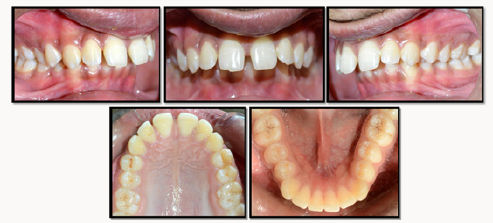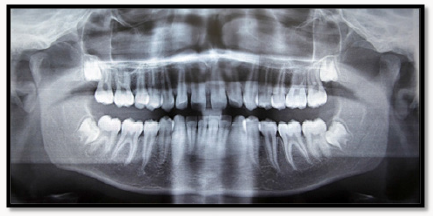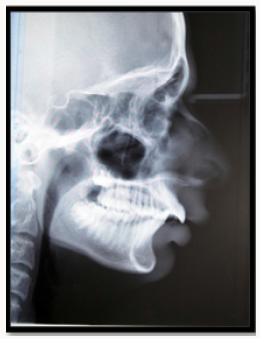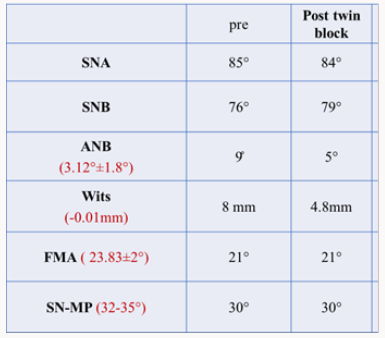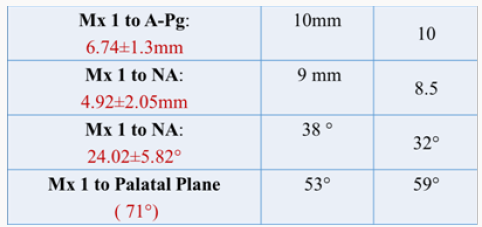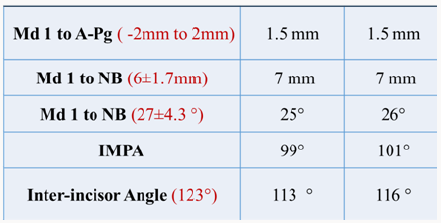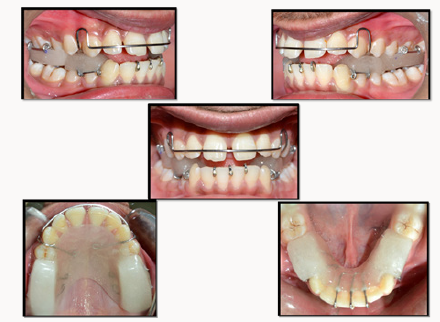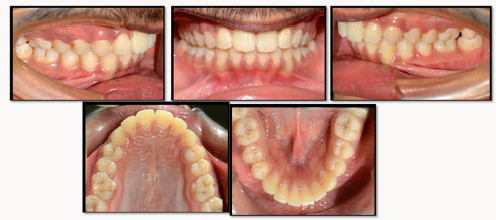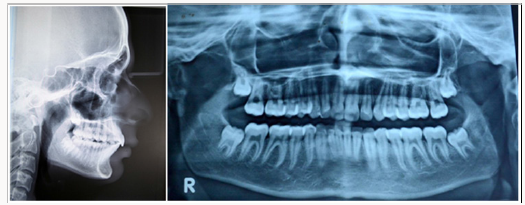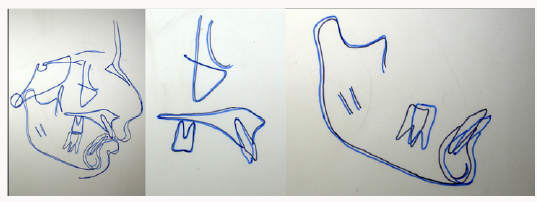
Lupine Publishers Group
Lupine Publishers
Menu
ISSN: 2637-6636
Case Report(ISSN: 2637-6636) 
Effect of Twin Block Appliance on a Growing Patient – A Case Report Volume 1 - Issue 4
Mohammad Tariq, Sandhya Maheshwari, Sarah Asif*, Yumna Qamar and Shubhra Pathak
- Department of Orthodontics and Dentofacial Orthopedics, Aligarh Muslim University, India
Received: April 30, 2018; Published: May 10, 2018
*Corresponding author: Sarah Asi, Department of Orthodontics and Dentofacial Orthopedics, Dr. Z. A. Dental College, Aligarh Muslim University, Aligarh, Uttar Pradesh, India
DOI: 10.32474/IPDOAJ.2018.01.000117
Abstract
Twin block appliance is very effective in a growing patient. The successful use of this appliance in the treatment of skeletal Class II malocclusion is based upon factors such as; age of patient, compliance of the patient and other case selection criteria. This case report includes a 14-year-old boy who was treated with twin block appliance. If treated timely, growth modification and orthopedic effects with this appliance can be achieved in a growing individual. This appliance is very successful in a patient with retruded mandible and well aligned arches in whom VTO is positive. This brings the mandible forward and improves the profile immediately
Keywords: Twin block appliance; Growth modification; Myofunctional appliance; bite jumping
Abbrevations: VTO-Visual Treatment Objective
Introduction
Class II malocclusion is one of the most common problems around the globe affecting around one-third of the patients who come for orthodontic treatment [1-4]. According to McNamara, mandibular retrusion is the most common characteristic of this malocclusion [1-5]. Functional appliances are the appliances which bring about skeletal and dental corrections in these Class II patients with retruded mandible by utilizing force from the surrounding musculature. They were introduced long back and are now popularly used to correct Class II malocclusion in growing patients. In 1982, Clark [6] described the twin block appliance. In United Kingdom, since then it has been continuously used in clinical practice [7]. A lot of evidences have proved that it is one of the most successful appliance used for the correction of skeletal class II patients which can be used in any kind of pattern i.e. either hypo divergent, normodivergent or hyper divergent pattern with slight modifications to the appliance design.
The amount of mandibular advancement in twin block construction varies from patient to patient. In case of limited over jet, bite can be registered by placing incisors in an edge to edge relation while in case of large over jet bite is usually registered 2-3 times by advancing the mandible gradually, which according to many authors brings about greater orthopedic changes. Following is a case report of a 14 year old boy with normodivergent growth pattern, treated with twin block appliance for correction in both sagittal and vertical planes.
Case Report
A 14 year old boy reported to the department with the chief complaint of forwardly placed upper front teeth and a non pleasing smile. Extra oral examination revealed that the patient had an apparently symmetrical face with a convex profile, competent lips, deep mento-labial sulcus with receded chin (Figure 1). Intraoral features showed a Class II Molar relation on left side and Endon molar relation on right side with Class II Canine relationship bilaterally, over jet of 9 mm, overbite of 90% and maxillary mid line and mandibular midline in concordance with the facial midline and with each other (Figure 2). Orthopantomogram of the patient revealed a permanent dentition stage with 3rd molar buds seen in all the quadrants (Figure 3).
Cephalometricanalysis (Figure 4) confirmed the case as Class II division 1 on a skeletal Class II base with mandibular deficiency along with ANB of 9° and Wits of 8mm (Figure 4a). Skeletal values confirmed a normally positioned maxilla with retruded mandible in relation to cranium with a normodivergent growth pattern shown by Frankfurt-mandibular plane angle as 21°(Figure 4b). Dento-alveolar findings showed proclined and protruded maxillary anterior and normally positioned mandibular incisors (Figure 4c). Cast analysis suggested a discrepancy of 3mm in maxillary arch and 2.6mm in the mandibular arch. Cephalogram (Figure 3) indicated that he was at the peak of his pubertal growth spurt (CVMI-IV) with a considerable amount of growth remaining. The patient also had a positive visual treatment objective (VTO) which also favored the use of mandibular advancement using the twin block appliance.
Treatment Objectives
a. Achieving Class I molar & canine relationship on both side.
b. Reduction of profile convexity and achieving optimum soft tissue balance.
c. Achievement of normal over jet and overbite.
d. Leveling and alignment of arches.
e. Long term retention.
Treatment plan
As the patient had skeletal and dental Class II relationship in growing phase, a two phase treatment was planned.
Phase I- Growth modification using functional appliance (twin block).
Phase II- Fixed orthodontic mechanotherapy for final detailing of occlusion.
Treatment progress
Bite registration was done with a forwardly placed mandible and twin block was fabricated for the patient (Figure 5). Patient was asked to wear the appliance for 24 hours a day and after a period of 6 months, significant improvement was noted in the profile of the patient with correction in molar and canine relation as well as the over jet and overbite (Figure 6a, 6b and 7). This active phase of growth was followed by a retentive phase where the patient was given a removable reverse inclined plate to retain the correction obtained.
Superimposition at cranial base showed mesialization of mandible with retraction of upper lip. Remodeling at B point was visible. Superimposition at maxilla showed retrusion of maxillary incisors with no change at the molars. Superimposition of mandible showed mesialisation of lower molars with increase in proclination of lower incisors.
Discussion
Class II malocclusion can have a skeletal component, a dental component or a combination of both. Skeletally it may result either due to maxillary prognathism, mandibular retrognathism or their combination [8]. Therefore, identifying and understanding the proper etiology becomes really important for a proper diagnosis and finally to make a proper and effective treatment plan that may help in achieving the desired results.
Twin block is a functional appliance that is used in growing patients with mandibular retrognathism to reposition mandible in a forward position. It utilizes the surrounding neuromuscular forces to bring about orthopedic and orthodontic changes thereby causing mandibular displacement. The main advantage of twin block is that it is esthetic and comfortable which allows the patient to wear it for 24 hours thus bringing about the changes at a faster rate. There have been several studies to document the ability of twin block to produce significant skeletal as well a dentoalveolar changes, which in combination correct Class II malocclusion. Here, comparison of pre-treatment and post-twin block treatment lateral cephalogram showed an increase in SNB by 3°. ANB angle reduced up to 4°. Inclination of maxillary incisors also got corrected and length of the mandible increased by 1.7mm. The values of selected parameters before and after functional appliance therapy are shown in Figure 4a-c.
Conclusion
Functional appliance therapy is an effective way of treating skeletal Class II malocclusion due to mandibular retrusion via growth modification,, however its effect depends upon patient compliance and case selection. Out of all the functional appliances, twin block, by far is one of the most popular functional appliances used and its use during growing phase with good patient cooperation can produce more of skeletal effects along with some dental effects.
References
- Prasad V Bond, Veerendra V Kerudi, Neeraj Patil, Siddhesh G Dolas, Harshal A Patil (2015) Treatment of Skeletal Class II Malocclusion with Twin-block. Journal of Applied Dental and Medical Sciences 1(3).
- Proffit WR, Fields HW, Moray LJ (1998) Prevalence of malocclusion and orthodontic treatment need in the United States: estimates from the NHANES III survey. Int J Adult Orthodon Orthognath Surg 13(2): 97–106.
- Gelgor IE, Karaman AI, Ercan E (2007) Prevalence of malocclusion among adolescents in central Anatolia. Eur J Dent 1(3): 125-131.
- Celikoglu M, Akpinar S, Yavuz I (2010) The pattern of malocclusion in a sample of orthodontic patients from Turkey. Med Oral Patol Oral Cir Bucal 15(5): e791-e796.
- McNamara JA (1981) Components of Class II malocclusion in children 8–10 years of age. Angle orthod 51(3): 177-202.
- Clark WJ (1988) The Twin Block technique. A functional orthopaedic appliance system. Am J Orthod Dentofac Orthop 93(1): 1-18.
- Mills JR (1991) The effect of functional appliances on the skeletal pattern. Br J Orthod 18(4): 267-275.
- Arici S, Akan H, Yakubov K, Arici N (2008) Effects of fixed functional appliance treatment on the temporomandibular joint. Am J Orthod Dentofacial Orthop 133(6): 809-814.
Editorial Manager:
Email:
pediatricdentistry@lupinepublishers.com

Top Editors
-

Mark E Smith
Bio chemistry
University of Texas Medical Branch, USA -

Lawrence A Presley
Department of Criminal Justice
Liberty University, USA -

Thomas W Miller
Department of Psychiatry
University of Kentucky, USA -

Gjumrakch Aliev
Department of Medicine
Gally International Biomedical Research & Consulting LLC, USA -

Christopher Bryant
Department of Urbanisation and Agricultural
Montreal university, USA -

Robert William Frare
Oral & Maxillofacial Pathology
New York University, USA -

Rudolph Modesto Navari
Gastroenterology and Hepatology
University of Alabama, UK -

Andrew Hague
Department of Medicine
Universities of Bradford, UK -

George Gregory Buttigieg
Maltese College of Obstetrics and Gynaecology, Europe -

Chen-Hsiung Yeh
Oncology
Circulogene Theranostics, England -
.png)
Emilio Bucio-Carrillo
Radiation Chemistry
National University of Mexico, USA -
.jpg)
Casey J Grenier
Analytical Chemistry
Wentworth Institute of Technology, USA -
Hany Atalah
Minimally Invasive Surgery
Mercer University school of Medicine, USA -

Abu-Hussein Muhamad
Pediatric Dentistry
University of Athens , Greece

The annual scholar awards from Lupine Publishers honor a selected number Read More...














